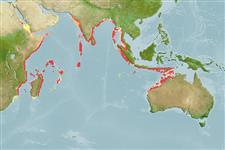Environment: milieu / climate zone / depth range / distribution range
экология
морской; пресноводный; солоноватоводный донно-пелагический; катадромный (Ref. 51243). Tropical; 23°N - 33°S
Asia: Pakistan, India, Sri Lanka, Burma, and the East Indies. Reported from Nepal (Ref. 9496, 12045) and Bangladesh (Ref. 1479).
Size / Вес / Возраст
Maturity: Lm ? range ? - ? cm
Max length : 200 cm TL самец/пол неопределен; (Ref. 85009); common length : 80.0 cm TL самец/пол неопределен; (Ref. 4832); наибольший вес (опубликованные данные): 6.0 kg (Ref. 1479)
Краткое описание
определительные ключи | морфология | морфометрия
членистые (мягкие) лучи спинного плавника (общее число) : 250 - 305; членистые (мягкие) лучи анального плавника: 220 - 250; позвонки: 106 - 112. Body elongate, head conical, flattened dorsally. Mouth terminal, lips prominent, narrow bands of teeth on jaws, broad band on vomer.
Lives in freshwaters, but also occurs in estuaries and in the sea during early life and near maturity (Ref. 4832). Occurs in freshwater streams, pools and reservoirs and commonly found in mud substrates of tanks and in deep rock pools of rivers (Ref. 41236). Most common eel in Indian inland waters. There exists a good export market for both live elvers and eels. Highly prized as food fish because of its nutritional value. Fish mucous from live fish mixed with rice or wheat flour is used as medicine for arthritis (Ref. 44150).
Life cycle and mating behavior
половая зрелость | размножение | нерест | икра | Fecundity | личинки
Talwar, P.K. and A.G. Jhingran, 1991. Inland fishes of India and adjacent countries. vol 1. A.A. Balkema, Rotterdam. i-liv + 1-541, 1 map (Ref. 4832)
Статус Красного Списка МСОП (Ref. 130435: Version 2024-2)
Угроза для людей
Harmless
Использование человеком
рыболовство: коммерческий; аквакультура (рыбоводство): предсказание будущего; объект спортивного рыболовства: да
дополнительная информация
инструменты
Специальные отчеты
Скачать в формате XML
ресурсы в Интернет
Estimates based on models
Preferred temperature (Ref.
123201): 26.2 - 29.3, mean 28.3 °C (based on 292 cells).
Phylogenetic diversity index (Ref.
82804): PD
50 = 0.5000 [Uniqueness, from 0.5 = low to 2.0 = high].
Bayesian length-weight: a=0.00076 (0.00037 - 0.00157), b=3.17 (3.00 - 3.34), in cm total length, based on LWR estimates for this Genus-body shape (Ref.
93245).
Trophic level (Ref.
69278): 3.8 ±0.7 se; based on size and trophs of closest relatives
устойчивость к внешним воздействиям (Ref.
120179): очень низкий, минимальное время удвоения популяции более 14 лет (Preliminary K or Fecundity.).
Fishing Vulnerability (Ref.
59153): Very high vulnerability (90 of 100).
Nutrients (Ref.
124155): Calcium = 25.7 [12.9, 56.8] mg/100g; Iron = 0.5 [0.3, 0.9] mg/100g; Protein = 18.2 [16.3, 20.3] %; Omega3 = 0.246 [0.109, 0.567] g/100g; Selenium = 184 [71, 424] μg/100g; VitaminA = 20.6 [3.6, 106.6] μg/100g; Zinc = 0.956 [0.596, 1.561] mg/100g (wet weight);
